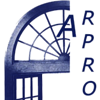@/Arpro devotes part of the procedures to the production of articles and transformation of these into BOMs. They are procedures aimed at production companies, which transform raw materials into semi-finished or finished products.
The development of the BOMs in the program is complete from a constructive point of view. Only within the operating procedures dedicated to production the program provides the management of the “Production Loads” tool.
A basic tool aimed at companies with simple production needs, considering that the @/Arpro Erp platform is the management base for a more complete and refined company production organization.
The procedures made available develop the following basic aspects:
- management of warehouse items, from raw materials to finished and/or semi-finished products;
- management of the work centers present in the company’s production department;
- organization of the production worksheets, connected to the different BOMs;
- BOMs management;
- the production phase is managed by production loads, for the sole transformation of semi-finished or finished products and the corresponding unloading of the warehouse.
The production phases require the organization of the warehouse articles, where all the articles must be coded, from the raw material to the finished ones (from the main menu select “Stock-Orders” + “Warehouse Articles”).
For all of the warehouse items that must be BOMs, before defining them in the production menu, activate the flag “BOM” in the article master data: from the main menu select “Stock-Orders” + “Warehouse Articles” + “Card” tab + “Other” button from the bottom toolbar.
At this point it is possible to define the BOMs in the dedicated management (from the main menu select “Production” + “BOMs”), defining constituent materials, tasks and other data of a technical nature.
Once these preliminary phases have been completed, we can move on to the so-called operational phase.
These steps are also necessary if the production platform @/Arpro Erp is activated at a later stage, in fact the latter is connected to the data base of the @/Arpro management program. In this case it will not be necessary to re-enter the preliminary data.
BOMs
This allows the management of finished or semi-finished items, creating the connections between these components and the related basic items, as well as the possible tasks necessary for the production of the BOMs.
For each BOM it is possible to insert a “Worksheet” which also summarizes the processing necessary to complete the finished or semi-finished product. There is also the possibility (optional), in this context to add a fixed cost of the processing card.
The “Worksheet” is automatically created as soon as the first machining operation is entered (Task/Work Center) in the BOM, in the “Tasks” internal tab. All of the inserted tasks will be connected to the single worksheet, this in turn will be connected to the BOM.
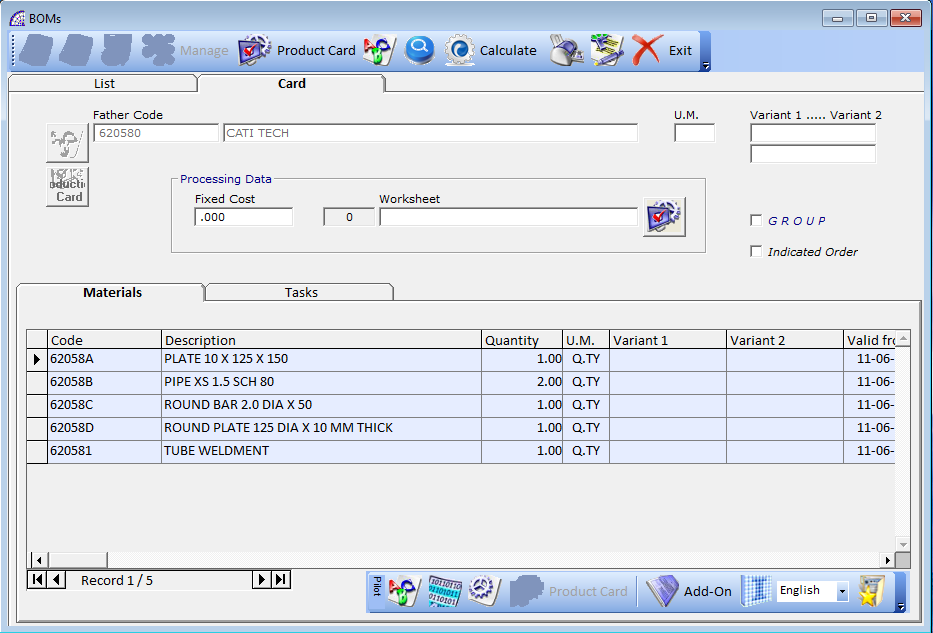
![]() create a BOM.
create a BOM.
Before this procedure, all of the necessary items must be created in the warehouse, including the BOM item (called the “Father Code”) which must be the first one to be inserted.![]() delete the created BOM. The operation is denied if the BOM item in warehouse has quantities in the loading situation (inventory). It is therefore necessary to download these values before canceling the BOM.
delete the created BOM. The operation is denied if the BOM item in warehouse has quantities in the loading situation (inventory). It is therefore necessary to download these values before canceling the BOM.![]() duplicate the selected BOM, you must first create the new BOM item in the warehouse.
duplicate the selected BOM, you must first create the new BOM item in the warehouse.![]() Manage: opens a window dedicated to managing multiple BOMs at the same time, the only ones displayed, provides the following processing procedures:
Manage: opens a window dedicated to managing multiple BOMs at the same time, the only ones displayed, provides the following processing procedures:
“Delete” -> delete the inserted article in all the displayed BOMs (if present).
“Expire” -> inserts the “Validity Date End” date in the inserted article, for all displayed BOMs (if present).
“Modify” -> allows you to replace one item with another, in all displayed BOMs.
“Add Component” -> adds a new article to all displayed BOMs.
“Update Articles” -> updates the data of all the items included in the displayed BOMs, with the updated data of the warehouses.
“Update Tasks” -> updates the data of all the tasks included in the displayed BOMs, with the updated data of the work centers (from the main menu select “Production” + “Work Centers”).
![]() Production Card: opens a window dedicated to technical data relating to the selected BOM.
Production Card: opens a window dedicated to technical data relating to the selected BOM.
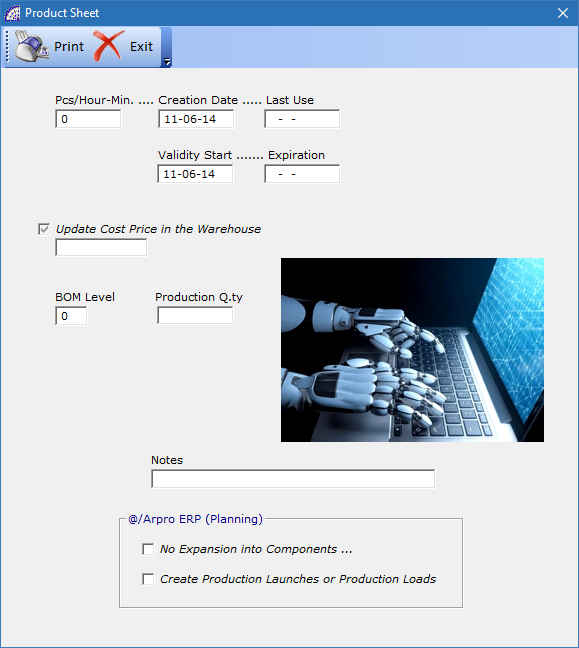
We find specific data on the Pcs/Hour-Min., Creation Date ….. Last Use, Validity and Expiration Date that affect the use of the BOM.
Update Cost Price in the Warehouse: this flag affects the calculation of the BOMs in the warehouse, during the production phases.
During the processing stages of production, in particular by executing a “Production Load”, the program after having effected in the warehouse the unload of the BOMS components and the load of the BOMs as products produced and now available, calculates the total cost of the BOMs.
The cost of each single BOM is given by the sum of the costs of the articles included in it and by the sum of the costs of the planned tasks (in this basic procedure there is no real production time detection system available), it is possible to also add fixed costs if present in the internal fields of the BOM itself.
If the flag in question is active and if there is a value in the field underlying the flag, during the loading phase of the BOMs produced, the program inserts the value mentioned above as the price of the last purchase and as cost value in the load situation.
The value present under the flag is entered manually or automatically updated by pressing the “Calculate” button on the toolbar.
BOM Level: free field available; managed through the procedure for importing the BOMs from an external Ascii file, present on the production platform @/Arpro Erp.
In this case it indicates the current BOM level, compared to others imported with the same operation.
Production Q.ty: free field available.
Notes: free note field available.
@/Arpro ERP (Planning)
Section dedicated to the production platform @/Arpro Erp, and in particular to the management of planning orders (in the program @/Arpro Erp, from the main menu select “Planning” + “Planning Orders” or “Supplier Order Creation”).
No Expansion into Components …: if active, during the processing of the order planning to supplier the BOM will not be divided into components but kept intact as if it were a single article.
Any “needs to be ordered” is connected to the “Father Code” article only.
Create Production Launches or Production Loads: if active, during the processing of the order planning to supplier the BOM will not be processed.
opens the windows of Properties, Packaging, U.M of the BOM.
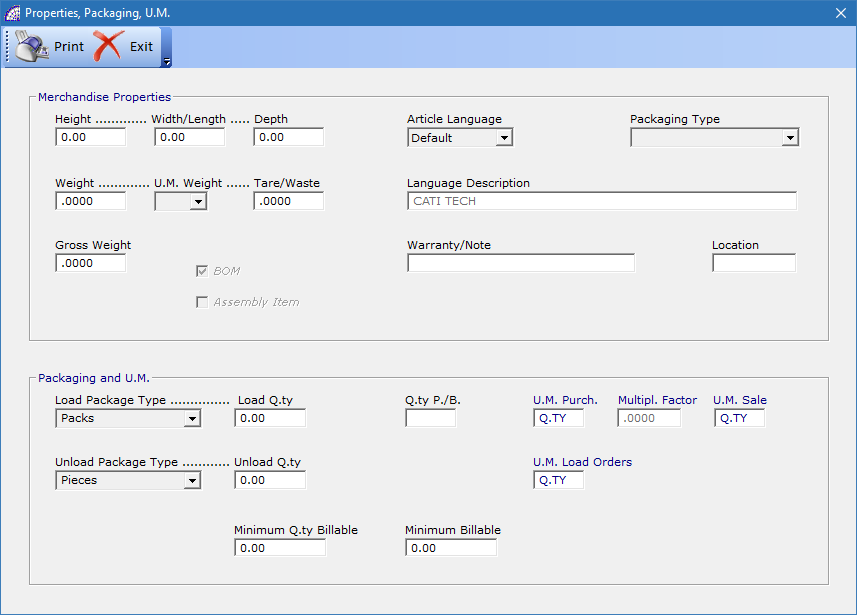
The data in this window are the same data of the warehouse item, corresponding to the Father Code (from the main menu select “Stock-Orders” + “Warehouse Articles” + “Card” tab + “Other” button in the bottom toolbar). Please refer to this section for more details.
opens the search conditions window. It depends on whether the button was pressed from the “List” or “Card” tab; in the second case, the search takes place exclusively for the articles composing the current BOM and the search options are different.
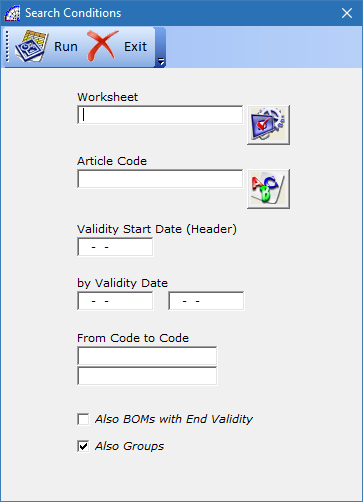
![]() it allows to calculate the cost of the BOMs; if the button was pressed in the “Card” tab, the search options are different, the calculation only affects the current BOM.
it allows to calculate the cost of the BOMs; if the button was pressed in the “Card” tab, the search options are different, the calculation only affects the current BOM.
Once the button has been pressed, it is necessary to confirm the reference deposit or warehouse, because if the calculation of the BOM is made by availability having more warehouses available (also those of subcontractors) the variations could be substantial.
Secondly, the type of calculation must be selected or confirmed: “Last Purchase Price” or “By Availability”. In the second case, the program verifies the availability of the items composing the single BOM in the warehouse; it can calculate the average real cost price, or take the last purchase price (like the previous mode).
When the button is pressed (second time), the program calculates the costs by summing the values of the articles and the tasks present.
The calculated value will be inserted in the BOM (“Product Card” window), in the warehouse, for the corresponding article, in the “Latest Purchase Price” field (from the main menu select “Stock-Orders” + “Warehouse Articles” + “Card” tab + “Buy” button in the bottom toolbar), as well as being displayed in the end of calculation message.
![]() opens the window of standard printouts available.
opens the window of standard printouts available.
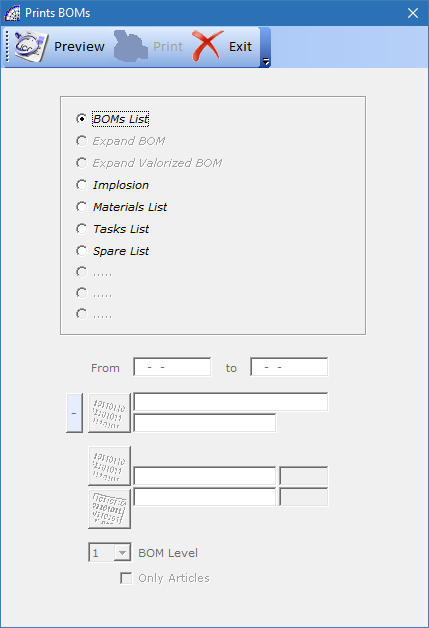
BOMs List -> print a list of displayed BOMs (active only from the “List” tab).
Expand BOM -> print in detail the list of articles and tasks that make up the BOM, without any cost value (active only from the “Card” tab). If you operate in the “BOM Level” combo box, you can also view the sub-level detail on the BOM (maximum 4 levels but the program has no limits on the number of levels).
Expand Valorized BOM -> similar to the previous print, in this case the cost values are also shown (active only from the “Card” tab). It is necessary to select the reference deposit or warehouse and the type of calculation: “Last Purchase Price” or “By Availability”.
Implosion -> The distinct implosion print allows you to search in which BOM a certain warehouse item is present. You need to select an article or confirm the current one, and pre-entered by the program, and the “BOM Level” in the relative combo-box.
Materials List -> Print the list of materials for a BOM, with details of quantity, validity, excluding production costs.
Tasks List -> Print the BOM machining list, with details on quantities and machine setup.
allows the insertion of an image in the BOM, in the envisaged graphic formats.
BOM (Body Data)
The body of the BOM is composed of several components: head data with references to the Worksheet and to all of the fields discussed previously and present in the specific windows, a card tab dedicated to the articles composing the BOM, a card tab dedicated to the Tasks.
In the tab reserved for the articles we find several fields, coming from the warehouse item once selected, as well as other management properties such as the validity dates, a flag that indicates if the item is in turn BOM.
There are no limits on the levels of the sub-BOMs, parent-child links between fathers and children. The quantity values for each item indicate the necessary to produce the BOM in quantities equal to 1.
Validity dates are important to define if a component article can still be used or has been replaced by a more recent one, so an expiration date has been inserted for the obsolete article. This consideration also concerns the production program @/Arpro Erp, in the part of automatic generation of orders to supplier, from inventory requirements or to meet the needs of new customer orders.
If the warehouse item is not open, by double-clicking on an article in the BOM, the program opens the warehouse and displays the selected item.
In the tab dedicated to Tasks, if there are data, we find the necessary processing for the production of the BOM (Q.ty = 1). Every single task has been inserted by selecting it from the list of Work Centers (from the main menu select “Production” + “Work Centers”), pressing the “Working” button in the bottom toolbar.
It is necessary to enter the data relative to the estimated working time (Use), the estimated time for the possible preparation of the machine or of the work center (Setup).
We talk about “estimated times” as the real processing times must be detected during the individual phases. The @/Arpro basic program does not provide for these operations, it is necessary to enable the @/Arpro Erp production platform which provides multiple detection systems and also integrates production management for job orders, a fully customizable system that can be adapted to the various business needs.
A final observation regards the “End/Start” field, which establishes the link between the different tasks included in the BOM. The field can take 2 states: “End/Start” (On) or “Start/Start” (Off).
“End/Start” requires that the current tasks has to be finished before starting the next one; “Start/Start” the current tasks and the next one (if it exists) has to be started at the same time.
This field assumes importance when a BOM or a Job Order that can also contains one or more BOMs, are represented in a Gantt® diagram.
The @/Arpro Erp program manages the BOMs and Job Orders, also allows connectivity to the Microsoft Project® program, from which you can extract graphs on the projections of production. In the latter case we also provide integrative procedures between the two different platforms, in source format for any customizations.
With regard to the insertion of warehouse items, the same applies to sales and purchase invoices. The same applies to the management of the attached documents (Add-On).
![]() allows the insertion of free notes associated to the BOM, these can be inserted in the documents together with the BOM articles. This note field can be inserted in various languages, selectable from those available in the combo-box on the side.
allows the insertion of free notes associated to the BOM, these can be inserted in the documents together with the BOM articles. This note field can be inserted in various languages, selectable from those available in the combo-box on the side.![]() view the tree diagram, then the structure, of the current BOM.
view the tree diagram, then the structure, of the current BOM.
WORKSHEETS
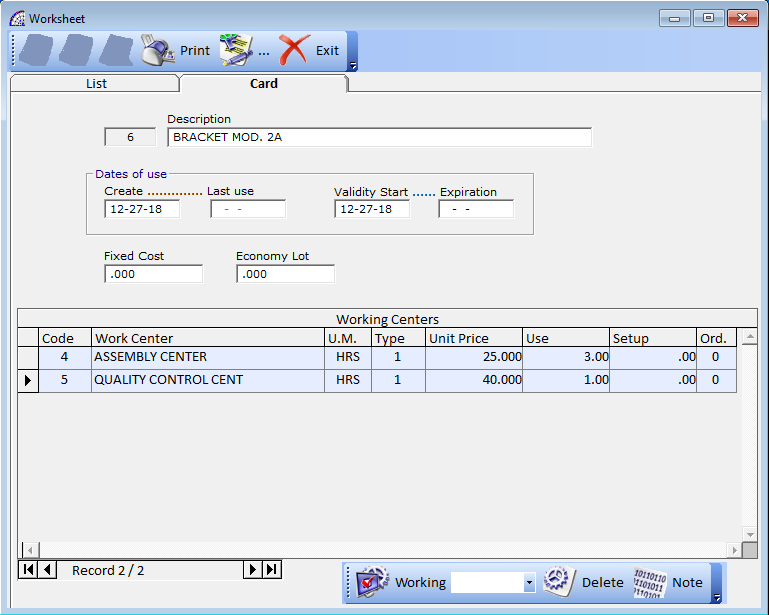
It manages the Worksheets of the BOMs where for each it displays the list of workings, in terms of Work Centers inserted, Unit Prices, Use and Machine Setup.
Like the BOMs, they present the dates of creation and use in the head data, as well as validity.
There are also two fields: “Fixed Cost” and “Economic Lot”. The first represents an optional value that will be added to the cost of the work centers, present in the body; the latter represents the ideal quantity of semi-finished or finished product to be produced.
For the rest, the considerations concerning the BOMs are the same.
WORK CENTERS
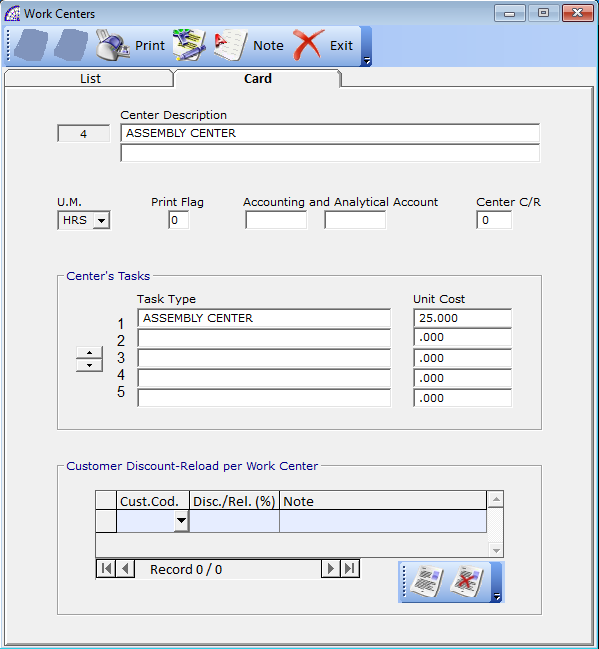
It manages the Work Centers of the business. In the company organization the work centers can be defined, normally in the production area and in the technical design office (if present), to detect processing times and therefore costs. Detect processing can be machine processing times and/or staff labor times.
For each work center it is possible to enter up to 10 different tasks, where a “Unit Cost” must be entered for each one. This cost represents the cost per unit of product processed by the type of processing under consideration.
In most cases only one “Task Type” is managed with the associated cost.
Customer Discount-Reload per Work Center
It is a section dedicated to the use of the Work Center in the management of Job Orders.
During the insertion of the Work Center in the Job Order, if the customer present in the production document corresponds to the one in this section, the program also includes the discount percentage or reload value in addition to the master data.
This is specifically oriented to production companies that manage discounts or different reloads, by customer and by Work Center.
OPERATORS
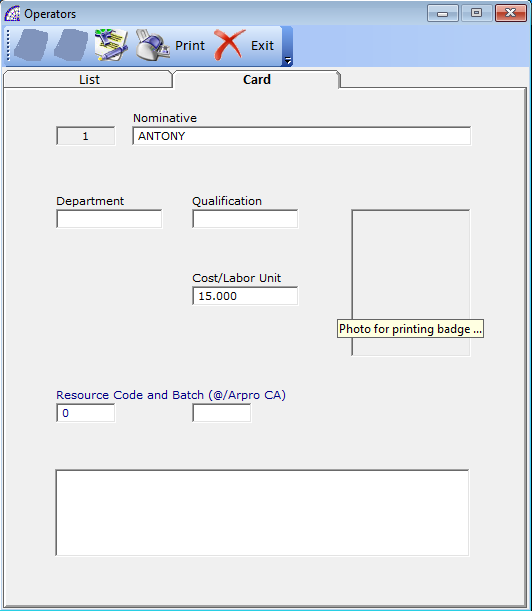
Manages operators for production phases, if any.
Once you have created an operator, you must enter a unique name or a code related to his/her Badge, fill in the available fields such as “Department”, “Qualification”, “Note”; considering that they are optional.
With regard to the “Cost/Labor Unit” field and in the context of production time detection, it is necessary to establish whether the cost must be entered in the Work Center, which assigns the operator in question, or directly in this field.
It is also possible to insert a photo of the operator and any notes in the field below.
PRODUCTION LOADS
The production load, unlike the other functionalities described above, represents the production tool offered by the base platform @/Arpro.
Used most of the time to “produce” semi-finished products, such as more complete BOM parts, or simple finished products where the estimated processing time is very close to reality. In all other cases, the production platform @/Arpro Erp must be purchased.
For all of the BOMs included in the production load, before being processed to confirm the production of the same, the program commits the components making up the BOMs themselves.
In practice, in the warehouse items in the “Prod. Q.ty” column (from the main menu select “Stock-Orders” + “Warehouse Articles”), quantities will be entered equal to the number of components necessary to produce the necessary BOMs. This will allow the warehouse manager to establish the inventory availability of the various products, as well as to determine which production load has committed them or reserved for the “future production”.
By confirming the production load, the program automatically creates 2 warehouse movements, one relating to the unloading of the components necessary for the production of the corresponding BOMs, and one for loading the BOMs, making them available in the warehouse for sale or storage.
After this operation, the program disengages the components engaged during the insertion phase of the single BOMs (column “Prod. Q.ty discussed above), values the costs of the single BOM (if provided for in its personal data), updates the dates of last use both of the BOMs and of Worksheets associated with them.
The article produced can belong to any level of BOM.
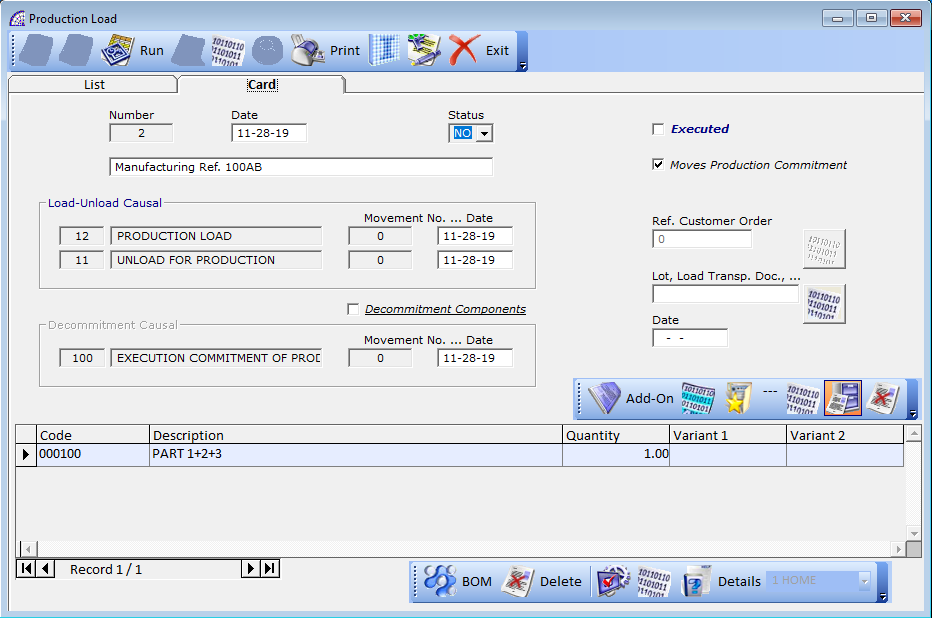
Production Load (Head Data)
We find several fields available: creation date, movement status (NO, YS, AN), one free description to distinguish it, if performed and processed (Executed), etc.
Moves Production Commitment: if disabled, during the phase of insertion of the BOMs, initial phases of production scheduling, or during the evasion processes, the program does not commit and consequently does not disengage the components.
This flag is normally activated; in special cases it may be necessary to deactivate it.
Ref. Customer Order: it is possible to insert the customer order reference, useful in the manual creation of production loads to have a reference to the document. It is possible to insert this reference only before inserting BOMs into the body of the movement.
Lot, Load Transp., Doc, …: it is possible to insert the document transport reference or a production lot or it could be useful for others references.
Date: represents the date of any document inserted above.
Load-Unload Causal: in this frame we find the data related to the movements generated during the execution phase of the production load (from the main menu select “Stock-Orders” + “Movements”). In particular, the production load related to the inserted BOMs or the production unload for the items making up the BOMs themselves.
In the “Movement No.” fields within the frame considered above, we will find the references of the warehouse movements created during the phase of evasion inserted.
Decommitment Causal: this frame is enabled if the “Decommitment Components” flag above is active. We find the data related to the movement generated during the insertion of BOMs into the production load.
Production Load (Body Data)
In the body we find the BOMs inserted for production, where for each, some of the necessary fields are displayed: Code, Description, Quantity (of BOM to be manufactured), Variant1-2 (optional).
Add-On: refer to the explanation described in “Attached Documents” section on this manual.
Variants Manager: displays a window for managing the variants and the loading situation of the components of the selected BOM.
The window is divided into 2 sections: the bottom one displays a list of the items of the BOM selected in the production load, while the one at the top shows the warehouse loading situation of the item selected in the lower window.
In the section above you can see the inventory situation in terms of quantity, ordered by supplier, committed by customer order. Both sections also report the values of any variants eventually present.
For more details on the variants, please refer to the relevant section in the present manual.
![]() view the tree diagram, then the structure, of the current BOM.
view the tree diagram, then the structure, of the current BOM.![]() loads the variants that may be present in the warehouse loading situation (from the main menu select “Stock-Orders” + “Warehouse Articles” + “Card” tab + “Situation” button in bottom toolbar), for each item that makes up the selected BOM.
loads the variants that may be present in the warehouse loading situation (from the main menu select “Stock-Orders” + “Warehouse Articles” + “Card” tab + “Situation” button in bottom toolbar), for each item that makes up the selected BOM.
Useful tool in cases with the need to use the variants available in the warehouse at the time of the production operation.![]() similar to the previous tool, it acts on all of the BOMs present in the production load.
similar to the previous tool, it acts on all of the BOMs present in the production load.![]() operates in the opposite way, eliminates any variants in the articles that make up the loaded BOMs.
operates in the opposite way, eliminates any variants in the articles that make up the loaded BOMs.
![]() BOMs: opens the warehouse items displaying the BOMs only, for selection and insertion in the production load. The previous considerations concerning the movements of committed articles are the same during the loading of the BOMs.
BOMs: opens the warehouse items displaying the BOMs only, for selection and insertion in the production load. The previous considerations concerning the movements of committed articles are the same during the loading of the BOMs.![]() Delete: eliminates the selected BOM and disengages the components of the same in the warehouse.
Delete: eliminates the selected BOM and disengages the components of the same in the warehouse.![]() displays the “Product Card” of the selected BOM (see the section of the BOMs for more details).
displays the “Product Card” of the selected BOM (see the section of the BOMs for more details).![]() displays the “Other” window of the selected BOM (see the section of the BOMs for more details).
displays the “Other” window of the selected BOM (see the section of the BOMs for more details).![]() displays a window with the possible variants of the selected BOM.
displays a window with the possible variants of the selected BOM.
PICKUP REQUIREMENTS
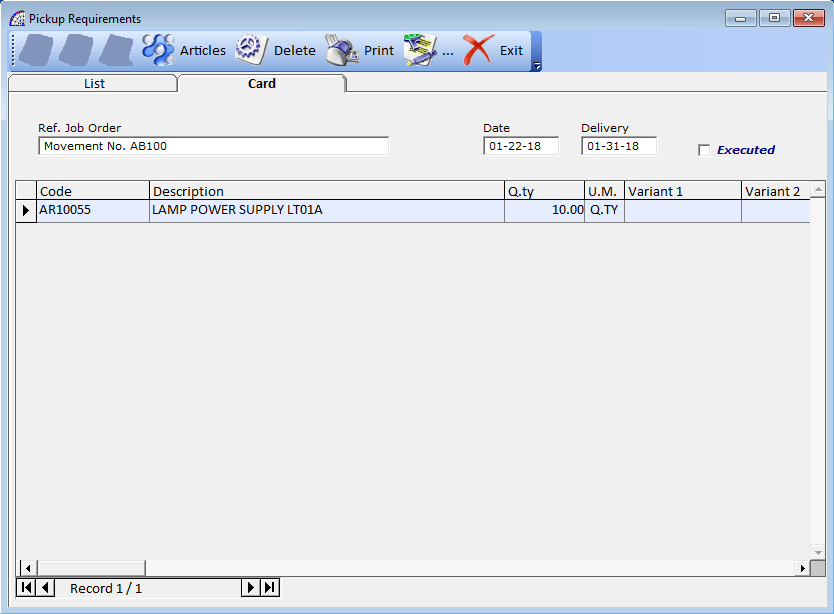
In the production area, one of the most important needs is to understand in advance what may happen in the sense of needs and withdrawals needed in the warehouse, against a possible production. Basically what has just been mentioned represents the possibility of managing a so-called “production simulation” of semi-finished or finished products, not in any way handling the warehouse article.
It is possible to insert semi-finished or finished articles (BOMs), in the quantities necessary for production in the Pickup Requirements Document. Naturally, these particular items must already be coded in the warehouse and the respective BOMs have already been created.
The goal is therefore to obtain productive prints that answer these requests: the needs, which will be analyzed by the purchasing office; the withdrawal list, necessary for the production departments.
@/Arpro Erp is our solution to meet these needs!
